TIPS – “Travel In Peace and Safety”
If we have learned nothing since the mythical fight of Iccurus, we could not be here today on the edge of technology looking at future commercial flights into space. Where once aviation was considered the deadliest form of transportation, it is now, and has been for a long time, the safest due to the pioneers that dedicated their lives so that we can enjoy the thrills and excitement of traveling. The only thing stopping us as passengers from reaping the benefits is our lack of understanding and willingness to accept the safety culture that is innately woven into the aerospace community.
From my first day of flight training in 1978, I was made aware of this safety culture by my flight instructor as he handed me the aircraft check list, looked me straight in the eye and said “This check list was written in pilots blood, learn it by heart and it will save your life one day”. He was absolutely right. Years later I experienced an in-flight engine failure that resulted in an emergency landing. While I was able to walk away from the accident unscathed, the aircraft did not. I owe a lot to the instructors and teachers that gave me the tools and experiences that have made me a passionate passenger safety advocate. I pass on to you the knowledge that has come from years of learning and participating in international safety conferences, accident investigations and one-on-one discussions with leading aviation safety experts.
Always travel in Peace and Safety,
Richard Chan
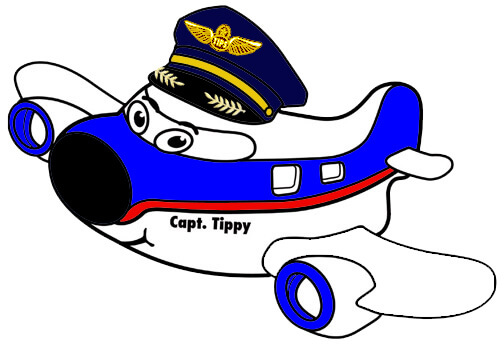
Make Your Safe Trip Even Safer
When you fly on the commercial airlines of the United States, you are flying on the safest, most efficient form of transportation. When the rare accident does occur, more and more people survive due to advances in aircraft technology.
Aviation manufactures, air carriers, and the Federal Aviation Administration are proud of their contributions to aviation’s impressive safety record. You, the air traveler, play a very important role in aviation travel today. You can take responsibility for your own safety.
- Keep Your Seat Belt Fastened
- Listen To The Safety Briefing And Your Flight Attendants
- Wear Sensible Clothing
- Obey Carry-On Baggage Restrictions
TIPS. Be responsible for your safety and make your trip even safer.
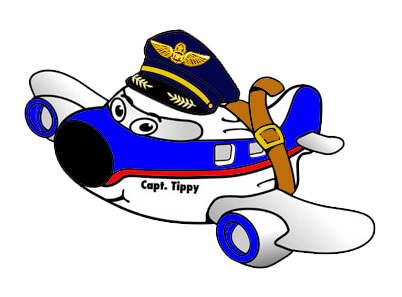
Fasten Your Seat Belt
Of all the safety features aboard the aircraft, one of the most important is right at your fingertips. Your Seat Belt. In a recent study, nearly 300 turbulence-related serious injuries to passengers were reported over a 10-year period. None of the injured had their seat belts fastened. To prevent turbulence injuries, TIPS travelers should always:
- Keep their seat belt fastened at all times.
- Make sure their seat belt is secured snug and low across the hips. This will prevent you from “submarining” under the seat belts if there was a sudden impact.
- Turbulence is hard to predict and is the #1 cause of in-flight injuries.

Listen To the Safety Briefing
TIPS travelers always listen to the safety briefing because they know that every aircraft could be different. The following are some tips to ensure that you are familiar with the aircraft you are on:
- Take the passenger safety card out of the seat pocket and follow along while you listen to the safety briefing. Always take a moment to review the card before subsequent take-offs and landings.
- One of the best things you can do to be prepared is to mentally plan the actions you would need to take in an emergency. As part of this plan, count seat rows between you and at least two exits (usually in front and behind you). Be familiar with all exits, their location and operation.
- If you have any questions about the safety procedures, or the information is not clear, ask the flight attendant. Flight attendants are safety professionals: they are trained in the safety procedures of the aircraft (they are there to save your a_ _, not kiss it).
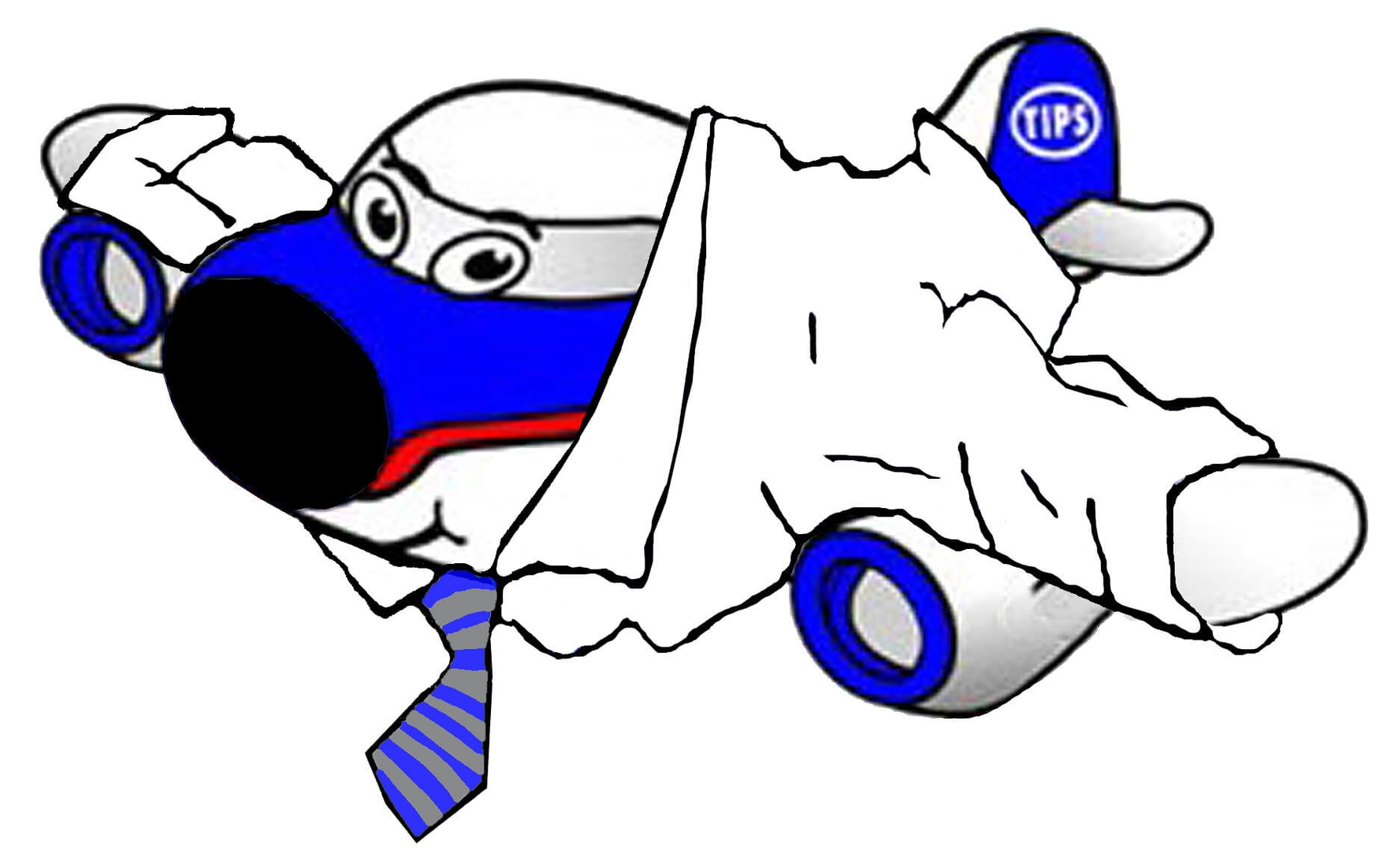
Wear Sensible Clothing
For ease of movement and protection in the unlikely event of an onboard incidence, TIPS travelers should follow these guidelines:
- Wear clothes made of natural fabrics such as cotton, wool, denim and leather. They offer the best protection. Synthetics (such as nylon and rayon) will melt when they are heated.
- Wear clothing that allows freedom of movement. Avoid restrictive clothing. Cabin pressurization causes nitrogen to expand in our bodies which can cause bloating. Loose fitting or expandable clothes will aid in your comfort during a long flight.
- Wear low-heeled shoes made of leather or canvas. (Shoes with laces or straps are recommended. Avoid sandals and rubber soled shoes).
- If you take your shoes off, put them on before each takeoff and each landing.
- Arms and legs should be as fully covered. (Long sleeves shirts and pants are recommended).
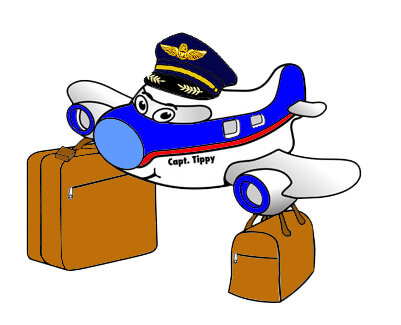
Obey Carry-On Baggage Restrictions
TIPS travelers should be aware of what they bring on board. Check with the TSA or your carrier for up to date information.
Make Your Trip Better Using 3-1-1
TSA and our security partners conducted extensive explosives testing since August 10, 2006 and determined that liquids, aerosols and gels, in limited quantities, are safe to bring aboard an aircraft. The one bag limit per traveler limits the total amount each traveler can bring. Consolidating the bottles into one bag and X-raying them separately from the carry-on bag enables security officers to quickly clear the items.
3-1-1 for carry-ons = 3.4 ounce (100ml) bottle or less (by volume) ; 1 quart-sized, clear, plastic, zip-top bag; 1 bag per passenger placed in screening bin. One-quart bag per person limits the total liquid volume each traveler can bring. 3.4 ounce (100ml) container size is a security measure.
Be prepared. Each time TSA searches a carry-on it slows down the line. Practicing 3-1-1 will ensure a faster and easier checkpoint experience.
3-1-1 is for short trips. If in doubt, put your liquids in checked luggage.
Declare larger liquids. Medications, baby formula and food, and breast milk are allowed in reasonable quantities exceeding three ounces and are not required to be in the zip-top bag. Declare these items for inspection at the checkpoint.
- Most airlines restrict carry-on baggage to two pieces per person. - - Carry-on bags must be small enough to fit under the seat in front of you or in the overhead bins. Place heavier items under the seat in front.
- Carry-on items could become flying projectiles during turbulence. Heavy items and baggage with sharp corners can be hazardous.
- Care should be taken while opening the overhead bins.
- Carry-on items should include medications, valuables and personal comfort items.
- During an emergency, retrieval of carry-on items may impede you and other passengers from evacuating the aircraft.
Some hazardous materials are restricted. They can be dangerous if carried (or checked) on an aircraft. Following is a partial list of common articles from the home, workplace, or garage, which, because of their physical or chemical properties, can pose a danger when, transported.
- Lithium batteries – must be removed from luggage that is checked (some newer suitcases have built-in batteries for charging phones, etc.) Lithium batteries can catch fire and must only be in carry-on luggage
- Mace, tear gas, and other irritants
- Aerosols containing flammable material (hair spray, deodorant, repellents)
- Loaded firearms
- Loose ammunition
- Propane, butane cylinders or refills, and lighter refills
- Wet-type batteries, e.g. as used in cars
- Fireworks and flares
- Safety or “strike-anywhere matches (in checked baggage)
- Paint and paint-related material (thinners and cleaners)
- Corrosive (acids), poisonous, infectious, and radioactive materials
The above list is not all inclusive. There are certain exceptions for personal care, medical needs, and equipment to support physically challenged passengers. There are also provisions for sporting equipment. When in doubt, check with your airline.
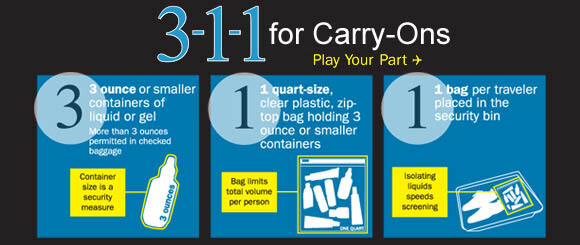
Safety TIPS for the TIPS Passenger
Alcohol and soda consumption
- Alcohol has twice the effect at altitude as it does at sea level.
- Alcohol will dehydrate your body.
- Gas molecules from carbonized drinks will expand under pressure. This can cause discomfort.
Child Safety Seat
- Check with airline for policy on use before arriving at the airport.
- Check to see if your child safety seat is FAA approved.
- For the safety of your child, TIPS recommends that your child be securely fastened in their own airline seat.
Decompression
In the unlikelihood the aircraft experiences decompression, oxygen masks will fall in front of you.
- Pull oxygen mask toward you to start the oxygen flow.
- Put your own oxygen mask on as quickly as possible. Hypoxia (oxygen deficiency) can take effect quickly.
- Then help children and others with their masks.
- To minimize facial burns, avoid using oil-based skin products.
Exit Row Seating
- Listen to the safety briefing and /or read passenger safety card. Be aware that the over-wing exit could weigh as much as 65 lbs.
- You must be physically capable and willing to perform emergency actions. If not, request another seat – other passengers are counting on your ability to operate the exit in case of an emergency.
- Before operating the door, listen for the flight attendant instructions. Look outside the aircraft to make sure it is safe to evacuate before removing the exit.
- You must know your responsibilities in the unlikely event of an emergency.
- Ask questions if instructions are not clear.
Window Seating
- Many passengers sitting next to windows nowadays keep the window shades closed during the entire flight, from before pushback to stopping at their destination gates. It is important to have the shades open for take-off and landing in case of an emergency. This allows flight attendants to assess the situation to determine which exits are viable.
Flotation Devices / Life Vests
- Know where they are and how to use them.
- Life vests (under seat, if available), life rafts, seat cushions and evacuations slides can be used as flotation devices.
- Inflate the life vest OUTSIDE the aircraft.
Evacuating the Aircraft
- Follow the instructions of crew members.
- Stay calm and proceed quickly to the nearest available exit.
- Leave all your possessions behind. Every 30 seconds that you are blocking the aisle retrieving your belongings, a fellow passenger could have evacuated.
Evacuating by slides
- Remove high-heeled shoes as they can pierce and damage the slide.
- Jump feet first into the center of the slide. Do not sit down to slide.
- Place arms across chest, elbows in, and legs and feet together.
Once outside the Aircraft
- Move away from the aircraft, in case of fire or smoke.
- If possible, help those requiring assistance.
- Remain alert for emergency vehicles.
- Never go back into an evacuated aircraft.
Fire and Smoke – Inflight
- Use wet paper towel or handkerchief over nose and mouth.
- Move away from source of fire and smoke.
Fire and Smoke – Ground
- Leave all your possessions behind.
- Stay low – Do not crawl, you don’t want to be a floor mat to the person behind you.
- Proceed by your predetermined count of seat rows to the exit(s).
- Follow floor proximity lighting to an exit.
- Exit and move away from the aircraft as soon as possible.

Symptoms of Traveling
Deep-Vein Thrombosis (DVT) is a health condition that can occur when people sit for long periods without moving. Blood in the legs can clot and with the lack of mobility. Combine that with the dry atmosphere in the cabin and the consumption of alcohol can result in the clots breaking off and migrating to the lung, causing pulmonary embolism that can result in death. Those in greatest risk are people with cardiovascular disease, cancer and blood disorders and those recovering from recent surgery. DVT can effect anyone and usually shows up within a couple of weeks after the flight. Symptoms include leg cramps, swelling or redness in a calf, shortness of breath and chest pain.
To prevent DVT from happening, hydrate yourself by drinking lots of water and stay away from caffeinated drinks and alcohol. Wear loose clothing to avoid constricting blood vessels. While in your seat you can exercise by doing foot presses where you move your feet up and down and in circles (make sure you are not bumping the seat in front of you and disturbing your fellow passengers). Wearing compression stockings will help increase blood circulation from the legs to the heart. Consult with your doctor before taking medicine or homeopathic remedies to prevent DVT.
More information can be found at https://wwwnc.cdc.gov/travel/page/dvt.
Some of the best information on this topic has come from Qantas Airlines that offers:
Your Health Inflight
At Qantas, we care about your comfort and safety. We have included the following information about your health inflight that we hope you will find helpful and useful.
When you are flying you can be seated and inactive for long periods of time. The environment can be low in humidity and pressurised up to an altitude of 2440 metres (8005 ft.) above sea level. Unlike other forms of transportation, air travel allows for rapid movement across many time zones, causing a disruption to the body’s “biological clock”.
Although these unique factors do not pose a health or safety threat to most customers, there are guidelines you can follow that will improve your comfort level during and after a flight.
We hope the following recommendations will help you have a more pleasant flight today and in the future.
Cabin Humidity/Dehydration
Humidity levels of less than 25 percent are common in the cabin. This is due to the extremely low humidity levels of the outside air supplied to the cabin. The low humidity can cause drying of the nose, throat and eyes and it can irritate contact lens wearers.
We recommend that you:
- Drink water and juices frequently during your flight.
- Drink coffee, tea and alcohol in moderation. These drinks act as diuretics, increasing the body’s dehydration.
- Remove contact lenses and wear glasses if your eyes are irritated.
- Have lubricating eye drops with you. This helps with eye fatigue.
- Use a skin moisturizer to refresh the skin.
Eating and Drinking
Proper eating and drinking will enhance your comfort both during and after your flight.
We recommend that you:
- Avoid over-eating just prior to and during the flight. It is difficult to digest too much food when the body is inactive.
- Drink coffee, tea and alcohol in moderation. These drinks act as diuretics, increasing the body’s dehydration.
Blood Circulation/Muscle Relaxation
When you’re sitting upright in a stationary position for a long period of time, several things can happen:
- The central blood vessels in your legs can be compressed, making it more difficult for the blood to get back to your heart.
- The long inactivity of your body muscles in this position can result in muscle tension, backaches, or a feeling of excessive fatigue during, or even after your flight.
- A stationary position inhibits the normal body mechanism for returning fluid to the heart, and gravity can cause the fluid to collect in your feet. This results in swollen feet after a long flight.
- Some studies have concluded that prolonged immobility may be a risk factor in the formation of blood clots in the legs (DVT – deep vein thrombosis). Particular medications and medical conditions may increase the risk of formation of blood clots if associated with prolonged immobility.
Medical research indicates that factors which may give you an increased risk of blood clots in the legs include:
- personal or family history of DVT
- recent surgery or injury, especially to lower limbs or abdomen
- blood disorders leading to increased clotting tendency
- immobilization for a day or more
- increasing age above 40 years
- estrogen hormone therapy, including oral contraceptives
- pregnancy
- tobacco smoking
- former or current malignant disease
- obesity
- dehydration
- heart failure
- varicose veins
Recommendations:
- If you fall into one of these categories or you have any concerns about your health and flying, Qantas recommends you seek medical advice before travelling.
- While inflight, move your legs and feet for three to four minutes per hour while seated and move about the cabin occasionally.
- At the bottom of the page is an inflight workout that you may like to try when flying with us.

Cabin Pressurization
It is necessary to pressurize the outside air drawn into the cabin to a sufficient density for your comfort and health. Cabins are pressurized to a maximum cabin altitude of 2440 metres. It is the same air pressure as if you were at an elevation of 2440 metres above sea level.
The cabin pressure and normal rates of change in cabin pressure during climb and descent do not pose a problem for most customers. However, if you suffer from upper respiratory or sinus infections, obstructive pulmonary diseases, anemia’s or certain cardiovascular conditions, you could experience discomfort.
Children and infants might experience some discomfort because of pressure changes during climb and descent.
If you are suffering from nasal congestion or allergies, use nasal sprays, decongestants and antihistamines 30 minutes prior to descent to help open up your ear and sinus passages.
If you have a cold, flu or hay fever, your sinuses could be impaired. Swollen membranes in your nose could block your Eustachian tubes – the tiny channels between your nasal passages and your middle ear chamber. This can cause discomfort during changes in cabin pressure, particularly during descent.
Recommendations:
- If you have a pre-existing medical condition that warrants supplemental oxygen, you can order from us. Please give at least seven days’ notice before travelling.
- To “clear” your ears, try swallowing and/or yawning. These actions help open your Eustachian tubes, equalizing pressure between your middle ear chamber and your throat.
- If you are flying with a head cold, many travel stores sell special earplugs to help keep ears “open” during descent. Insert them just prior to descent.
- When flying with an infant, feed or give your baby a dummy (pacifier) during descent. Sucking and swallowing will help infants equalize the pressure in their ears.
Jet Lag
The main cause of jet lag is travelling to a different time zone without giving the body a chance to adjust to new night-day cycles. In general, the more time zones you cross during your flight, the more your biological clock is disturbed. The common symptoms are sleeplessness, tiredness, loss of appetite or appetite at odd hours.
To try to minimize the effects of jet lag, we recommend that you:
- Get a good night’s rest before your flight.
- If possible, give yourself a day or two to adjust to the new time zone after arrival
- Fly direct to minimize flight time, when possible. This allows you to relax more upon arrival.
- Try some light exercise, go for a brisk walk, or do some reading, if you can’t sleep after arrival at your destination. It generally takes the body’s biological clock approximately one day to adjust per time zone crossed.
Motion Sickness
This ailment is caused by a conflict between the body’s sense of vision and its sense of equilibrium. Air turbulence increases its likelihood because it can cause movement of the fluid in the vestibular apparatus of the inner ear. If you have good visual cues (keeping your eyes fixed on a non-moving object), motion sickness is less likely to occur.
Recommendations:
- When the weather is clear and you can see the ground, sea or horizon, you are less susceptible to motion sickness.
You can buy over the counter medications but we recommend that you consult your doctor about the appropriate medications.
Passenger Etiquette
To help make the flight pleasant for all passengers, we offer these TIPS on passenger etiquette:
- Don’t slam tray table up to the lock.
- Most seat backs now have touchscreens. Please consider the passenger in front of you. Some passengers will push harder than necessary to make selections, disturbing the passenger seated in front of them.
- Do not rest your feet/foot in the space between the two seats in front of you (armrest area).
Your kindness and consideration is appreciated by fellow passengers, cabin crew, and flight crew alike.

Inflight Workout
These exercises are designed to encourage a safe way to enjoy movement and stretch certain muscle groups that can become stiff as a result of long periods of sitting. They may be effective at increasing the body’s blood circulation and massaging the muscles.
We recommend you do these exercises for three or four minutes every hour and occasionally get out of your seat and walk down the aisles.
Each exercise should be done with minimal disturbance to other passengers. None of the following exercises should be performed if they cause pain or cannot be done with ease.
Ankle Circles
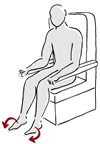 Lift feet off the floor. Draw a circle with the toes, simultaneously moving one foot clockwise and the other foot counterclockwise. Reverse circles. Do each direction for 15 seconds. Repeat if desired.
Lift feet off the floor. Draw a circle with the toes, simultaneously moving one foot clockwise and the other foot counterclockwise. Reverse circles. Do each direction for 15 seconds. Repeat if desired.
Foot Pumps
Foot motion is in three stages:

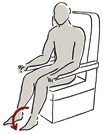

- Start with both heels on the floor and point feet upward as high as you can
- Put both feet flat on the floor
- Lift heels high, keeping balls of feet on the floor.
Continue these three stages with continuous motion in 30-second intervals.
Knee Lifts
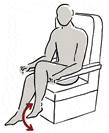 Lift leg with knee bent while contracting your thigh muscle. Alternate legs. Repeat 20-30 times for each leg.
Lift leg with knee bent while contracting your thigh muscle. Alternate legs. Repeat 20-30 times for each leg.
Neck Roll
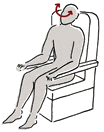 With shoulders relaxed, drop ear to shoulder and gently roll neck forward and back, holding each position about five seconds. Repeat five times.
With shoulders relaxed, drop ear to shoulder and gently roll neck forward and back, holding each position about five seconds. Repeat five times.
Knee To Chest
 Bend forward slightly. Clasp hands around the left knee and hug it to your chest. Hold stretch for 15 seconds. Keeping hands around the knee, slowly let it down. Alternate legs. Repeat 10 times.
Bend forward slightly. Clasp hands around the left knee and hug it to your chest. Hold stretch for 15 seconds. Keeping hands around the knee, slowly let it down. Alternate legs. Repeat 10 times.
Forward Flex
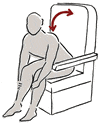 With both feet on the floor and stomach held in, slowly bend forward and walk your hands down the front of your legs toward your ankles. Hold stretch for 15 seconds and slowly sit back.
With both feet on the floor and stomach held in, slowly bend forward and walk your hands down the front of your legs toward your ankles. Hold stretch for 15 seconds and slowly sit back.
Shoulder Roll
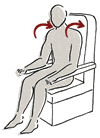 Hunch shoulders forward, then upward, then backward, then downward, using a gentle circular motion.
Hunch shoulders forward, then upward, then backward, then downward, using a gentle circular motion.
From your friends at Aero Mock-Ups, we hope that wherever your journey takes you, you will always Travel In Peace and Safety and be a safe TIPS Passenger.

